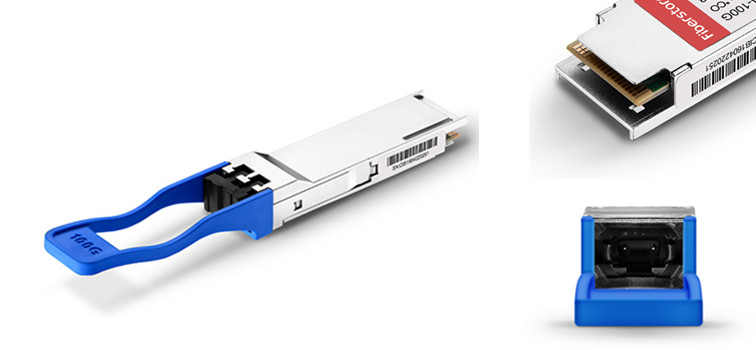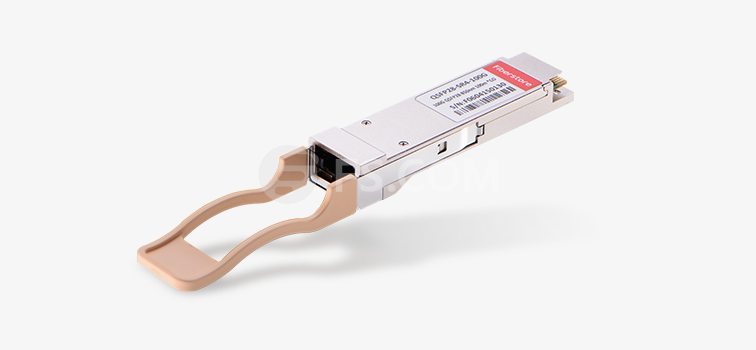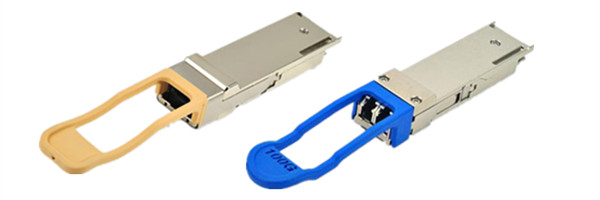Tag Archives: QSFP28
Difference Between 100G-QSFP-PSM4, 100G-QSFP-SR4 and 100G-QSFP-LR4
QSFP28 fiber optic transceiver is becoming the preferred solution for 100G network. It has the same outside looking as the 40G QSFP+ transceiver. But it has a 4*25G electrical interfaces which can transmit optical signals up to 100G. The part numbers of the QSFP28 transceivers are usually market as 100G-QSFP-xx. Now there is a wide selection of 100G QSFP28 modules for 100G Ethernet link, including fiber optic transceiver and direct attached cable. Different part numbers of 100G modules are making customers confused. This post will introduce the differences between the three 100G QSFP28 modules: 100G-QSFP-PSM4, 100G-QSFP-SR4 and 100G-QSFP-LR4.

It is known that QSFP28 modules generally use four lanes to transmit 100G with each lane supporting 25G. Thus, the transmission method is just like 40G QSFP+ transceiver. 100G QSFP28 SR4, LR4 and PSM4 all use the 4*25 transmission mode. However, both the QSFP28 SR4 and QSFP28 PSM4 use a 12-fiber MTP interface which achieves dual-way 100G transmission over 8 fibers at the same time. QSFP28 LR4 uses a LC duplex fiber optic interface for 100G transmission on two directions at the same time. QSFP28 LR4 transmit optical signals over four different wavelengths around 1310nm with each wavelength carrying 25G optical signal. The wavelength ranges of the four lanes are as following:
- 1294.53nm-1296.59nm
- 1299.02nm-1301.09nm
- 1303.54nm-1305.63nm
- 1308.09nm-1310.19nm
The three modules can support different transmission distances. 100G-SR4 QSFP28 module works over wavelength of 850nm and is used with 12-fiber MTP OM3 or OM4 multimode fiber cables for short transmission distances up to 100m. 100G-LR4 QSFP28 module is suggested to be used with single-mode fiber. It works over 1310nm wavelengths and can transmit 100G signals up to 2km. 100G-PSM4 QSFP28 is also used with 12-fiber MTP fiber cables but the fiber type is single-mode and the transmission distance is up to 500m.

The transmission mode of the fiber optic transceiver plays an important role during fiber cabling. 100G-QSFP-SR4 and 100G-QSFP-LR4 are invented for short distance transmission and long distance transmission separately. However, the have different cabling structure. The former requires a multi-fiber cabling structure based on 12-fiber MMF MTP interfaces. While 100G-QSFP-LR4 just required the traditional two-fiber SMF cabling structure. In this case, the conversion between multimode fiber to single-mode fiber would be complex as they used totally different cabling structure. Thus, 100G-QSFP-PSM4 is invented which runs over single-mode fiber, but uses the same cabling structure as 100G-QSFP-SR4. With 100G-QSFP-PSM4, the conversion between multimode and single-mode would save more without changing the existing fiber cabling structure.
| 100G QSFP28 Transceiver | Data Rate | Interface | Fiber Type | Transmission Distance |
Wavelengths | Cabling Structure |
| 100G-QSFP-SR4 | 4*25G | MTP | MMF | 70m (OM3); 100m (OM4) |
850nm | 12-Fiber MTP |
| 100G-QSFP-LR4 | 4*25G | LC | SMF | 2km | 1310nm | LC Duplex |
| 100G-QSFP-PSM4 | 4*25G | MTP | SMF | 500m | 1310nm | 12-Fiber MTP |
The above table listed the basic information of the three modules for your referent. 100G-QSFP-SR4 are suitable for short distance transmission over OM3 or OM4 fiber using 12-MTP fiber cabling system. 100G-QSFP-PSM4 also has a 12-fiber MTP interface but it can support a transmission distance up to 500m over SMF. 100G-QSFP-LR4 is suitable for long transmission distance up to 2km over two single-mode fibers.
Related Article: 40G vs 100G: Which One Is Worth the Investment?
Double Density QSFP (QSFP-DD) Is Coming
Recently the building of QSFP-DD (Multi Source Agreement) Group has excited optical communication industry. This group, including 13 members which are all the leading vendors in the industry, like Cisco, Brocade and Finisar, aims to create a upgraded version of QSFP transceiver, which is called QSFP-DD ( double density QSFP) and will be able to support 200G/400G Ethernet.
The QSFP-DD is similar to the current QSFP. But there are many differences between the current QSFP. The reason why the new transceiver is called “double density” is related to the current 100G QSFP28 transceivers. The “double density” means the doubling of the number of high-speed electrical interfaces that the module supports compare to regular QSFP28 module.

We can understand the QSFP-DD better by comparing it with the current 100G QSFP28 module. QSFP28 transceiver is a four-channel transceiver which is able to transmit and receive 100G per second simultaneously. With the advantages of high speed and low power, QSFP28 transceiver is becoming more popular than other 100G transceivers like CFP2 and CFP4. The 100G QSFP28 transceiver is implemented with four lanes with each supporting data rate of 25G.
The working principle of QSFP-DD is similar with 100G QSFP28 transceiver. The QSFP-DD MSA group will increase the lane to eight. There will be a row of contacts providing for an eight lane electrical interface in QSFP-DD. If modulated by NEZ, each lane of the QSFP-DD can support data rate up to 25G, thus, it can support a total data rate of 200G. If modulated by PAM4, it can support data rate up to 400G with each lane supporting data rate of 50G. The MSA group also announced that the QSFP-DD can enable up to 14.4Tbps aggregate bandwidth in a single switch slot, which can definitely satisfy the increasing need for higher bandwidth.
Another great feature of QSFP-DD is that its system will be backwards compatible, allowing them to support existing QSFP modules and provide flexibility for end users and system designer. This means the data center could save a considerable sum of money in the future upgrading.
The appearance of QSFP28 transceiver has changed the regular development road map of Ethernet. The regular upgrade road is 10G to 40G and then 100G. While the QSFP28 transceiver has changed it from 25G directly to 100G. The road map of this QSFP-DD is also drawing our attention. It is predicted that it will become a useful family of modules for the industry with application at greater than 400G. Meanwhile, there is no efforts underway to define these new speeds but it is expected that QSFP-DD will have a roadmap that supports.

Any way, no matter where the QSFP-DD lead our Ethernet to, it is good news for our future networking system. The creating of this new module will still need some time. For now, many data centers are considering about upgrading their data center with 100G QSFP28 transceivers. And there are a variety of switches which support QSFP28 interfaces on the market. However, 100G QSFP28 transceiver is still not cheap in the current market. For example, the price of a 100GBASE-SR4 QSFP28 transceiver is generally more than $2000.00. However, in FS.COM, supported by OEM, the price is much more favorable. A 100GBASE-SR4 QSFP28 transceiver only cost $650.00 in FS.COM. The following chart is detailed information of 100G QSFP28 transceivers in FS.COM.
| FS P/N | Form Type | Data Rate | Wavelength | Max Cable Distance | Interface | Cable Type | DOM Support |
| 100G QSFP28-SR4 | QSFP28 | 103.1 Gbps | 850 nm | 100 m | MPO (MTP12) | MMF | Yes |
| 100G QSFP28-LR4 | QSFP28 | 103.1 Gbps | 1310 nm | 10 km | LC Duplex | SMF | Yes |
For more details, please contact us at sales@fs.com or visit FS.COM.
Related Articles: 40GBASE QSFP+ AOC VS 40GBASE SR4 QSFP+ Transceiver
